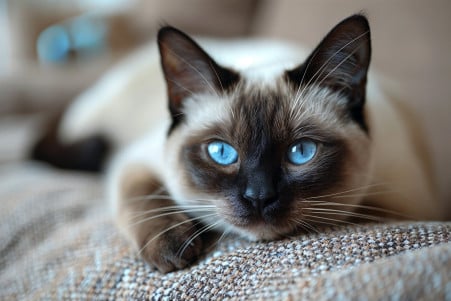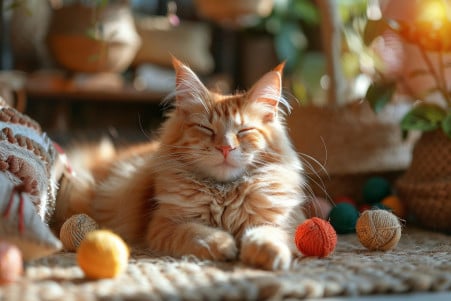Do Cats Have ADHD? Exploring Feline Hyperactivity and Other Behaviors
9 February 2024 • Updated 9 February 2024

Cat parents are no strangers to their pets’ crazy behavior, but is it ADHD? While cats can’t be diagnosed with ADHD because it’s a condition that’s only defined for humans, they can certainly exhibit signs of hyperactivity and distractibility that are similar to the symptoms of ADHD.
If you’re concerned about your cat’s behavior, it’s always best to talk to your vet to rule out medical issues and to make sure you’re not missing any environmental factors.
In this article, we’ll take a deep dive into the world of veterinary behaviorism and animal psychology to understand the behaviors that are often mistaken for ADHD in cats. We’ll look at veterinary research and expert opinions to explore the natural range of cat activity levels, as well as the role of personality and environment.
We’ll also look at how enrichment and regular health checkups can help you deal with hyperactivity in cats to give you a well-rounded view of your cat’s behavior and health while also respecting the nuances of animal behavior.
Do cats have ADHD?
Mythbusting: Can Cats Suffer from ADHD?
The human diagnosis of Attention-Deficit/Hyperactivity Disorder, or ADHD, is characterized by specific behaviors, such as hyperactivity, inattention, and impulsivity. However, as Catster points out, these behaviors in cats are not the same as ADHD, which is not recognized in feline medicine.
While cats may show signs of ADHD, such as being easily distracted or having bursts of energy, which many cat owners call “zoomies,” these behaviors are often normal parts of a cat’s behavior and are rooted in their natural instincts, such as hunting and exploring.
A cat’s behavior is a result of a combination of factors, including genetics, individual personality traits, like those outlined in the “Feline 5 Key Personality Factors,” and life experiences.
For example, a cat’s inability to socialize with other pets is more likely due to a lack of socialization than an attention disorder, which underscores the importance of looking at a cat’s history. To better understand these behaviors, it’s important to not anthropomorphize our cats and instead understand their behaviors within the context of their natural behavior.
Recognizing Your Cat’s Natural and Abnormal Behaviors
Cats are known for their entertaining and sometimes puzzling behaviors. Normal cat behaviors include being playful, with cats playing in a variety of ways that include pouncing and stalking, which are based on their natural hunting instincts.
Social behavior is also important, with cats forming social relationships that are important for their emotional well-being, according to Cat Health. However, some behaviors can be a sign of a medical problem or a problem with their environment, including hiding, refusing to eat, and aggression, according to the Cornell University College of Veterinary Medicine.
A cat’s behavior is also influenced by their environment. For example, a stimulating environment that includes perches and windows can improve a cat’s quality of life, according to Tuft + Paw, while a lack of mental stimulation and a stressful environment can lead to behavioral problems. Stress-related behaviors can include overgrooming and not using the litter box.
It’s important to know your cat’s normal behavior so you can recognize when something is wrong. If you notice a change in behavior that could be a sign of a medical problem or a problem with their environment, experts recommend seeking help from a veterinarian. By recognizing and meeting their instinctual needs and looking for signs of abnormal behavior, you can help ensure your cat’s well-being.
How to Deal With Hyperactivity in Cats: Play and Environmental Solutions
Hyperactivity in cats can be caused by inherent breed characteristics or individual differences in energy levels. While some breeds, such as the highly active Abyssinian, are known for their energy, other cats may simply be more active due to their unique personalities.
However, it’s important to note that, before you jump to any conclusions about a cat’s behavior, it’s important to make sure that you’re not mistaking normal, healthy activity for hyperactivity, which may be a sign of an underlying medical issue.
Non-medical solutions for dealing with hyperactivity often focus on increasing a cat’s playtime and environmental stimulation. A study in the Journal of Feline Medicine and Surgery found that environmental enrichment that includes toys and activities that allow cats to engage in natural behaviors can have a “profound” impact on a cat’s welfare.
Meanwhile, a study in PMC found that environmental enrichment that includes things like perches and puzzle feeders can help cats feel less frustrated and more satisfied.
While it’s important to make sure that a cat’s physical and mental needs are being met, if a cat’s hyperactivity comes on suddenly, it’s important to take them to the vet to make sure that there isn’t an underlying medical issue.
That said, as a study in PubMed notes, creating an enriched environment that allows cats to engage in their natural behaviors, such as exploration and play, can help prevent boredom and manage excess energy.
By doing this, cat owners can help their pets live more fulfilling, satisfying lives and lay the groundwork for a deeper understanding of feline behavior and welfare.
Animal Behavior Disorders: What Veterinary Medicine Tells Us
The study of animal behavior disorders in veterinary medicine, including those that are similar to ADHD in humans, is a rapidly growing area. As Wikipedia’s entry on animal psychopathology notes, these maladaptive behaviors can be a sign of cognitive impairment or emotional problems. Veterinarians diagnose these disorders by observing and noting behaviors that deviate from the norm, taking into account the challenges of understanding animal minds and the lack of verbal communication.
Veterinarians typically take an integrative approach to treating these disorders, combining medical and behavioral treatments. For example, the genetic factors that contribute to obsessive-compulsive behaviors in dogs, as noted in a study published on DOI.org, can be treated with drugs and changes to the dog’s environment. It’s important to take a holistic approach that considers the animal’s physical and emotional health when treating animal behavior disorders.
A more in-depth look at these disorders in a veterinary context shows that, while cats may not have ADHD, they can have a range of complex behaviors. Successfully treating these behaviors requires a combination of medical and behavioral treatments that can be tailored to the individual animal, taking into account the subtleties of feline cognition and behavior.
Inside the Mind of a Cat: Cognitive Skills and Mental Processes
Cats have a wide range of cognitive skills, including learning, memory, and attention, that shape their behavior and how they interact with the world around them. A study published in the journal PMC found that cats can create mental images of their owners when they can’t see them based on their voices, which suggests cats have a level of socio-spatial cognition that has not been previously acknowledged.
These cognitive abilities can lead to behaviors that cat owners may mistakenly think of as ADHD-like, including hyperfocus and exaggerated responses to sounds.
A narrative review published in the journal PMC noted that cats can experience cognitive decline as they get older that is similar to Alzheimer’s disease in humans. This can lead to changes in behavior that may be misinterpreted as hyperactivity or inattention. It’s important to understand these cognitive changes so that cat owners can make sure their pets are well-cared for and living in an environment that meets their needs as they age.
Understanding the cognitive skills that cats have also emphasizes the importance of taking an individualized approach to pet care that takes into account the mental and physical needs of each cat. By understanding the cognitive complexity of cats, cat owners can better understand their pets’ behaviors and make sure they are in an environment that keeps them mentally stimulated and healthy throughout their lives.
It’s All Good: A Few Thoughts on Feline Behavior
Our deep dive into the world of cat behavior and the question of whether cats can have ADHD has shown that, while cats can’t have ADHD, many of their behaviors are completely normal and can be explained by their instincts and personalities. Cats display a variety of species-typical behaviors, from the hyperactivity of the zoomies to the inattentiveness of hyperfocus.
It’s also important to remember the role of environmental enrichment. Research on cat welfare has shown that a rich environment can help cats express their natural behaviors in positive, healthy ways. Finally, it’s important to remember that responsible pet ownership includes taking cats to the vet when their behavior changes. A vet can help you determine if your cat’s behavior is just a quirk or if it’s a sign of a medical problem.
In the end, the depth and complexity of cat behavior is something to be celebrated and respected. Instead of trying to simplify or pathologize their behavior, we should work to make sure that the environments we provide our cats and the care we give them are in line with their unique needs.
In doing so, we can honor the depth of our relationships with these mysterious animals and make our lives with them even richer with every purr and pounce.


